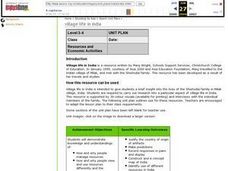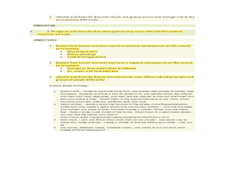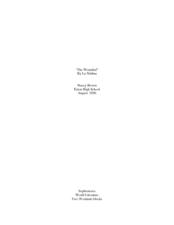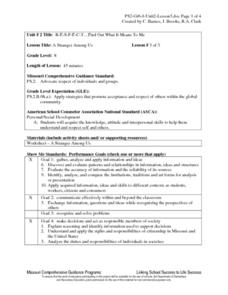Curated OER
Lesson: Urban China: Contemporary China
The urbanization and consumerism of modern China is the hot topic up for critical analysis. Kids view a series of photographs that specifically describe Chinese modernization, urbanization, consumerism, and waste. They discuss each...
Curated OER
Village Life in India
Students use included links to research the lives of people living in a small village in India.
Curated OER
Lesson: Snake Handling
Are the studies of art and archeology connected? You bet they are! Young scholars research the ancient temples of Mexico by visiting an archaeology site. They describe the various temples they see, taking note of shapes, stairs, details,...
Curated OER
Should Art Be for Art's Sake?
High schoolers examine how European-America aestheticians (philosophers of art) do not all agree about the value and definition of art. students examine how some cultures do not have a distinct word or definition for art.
New Class Museum
Lesson: Elizabeth Peyton: Portraits: Androgyny in Contemporary Culture
Portraiture, artistic expression, romanticism, and androgyny are discussed in a thought-provoking activity. Upper graders first discuss and examine the history of portraiture and the elements common to the Romantic style. Then they turn...
Curated OER
Native American Story Necklaces
Combine a study of Native American history and art in this lesson. Learners discuss the importance of fetishes in Native American culture, the history of necklaces, and create their own works of art. Your class will find this to be both...
Maryland Department of Education
The Concept of Diversity in World Literature Lesson 1: Unit Introduction
To launch a unit study of the concept of diversity in World Literature, class members compare Chinua Achebe's essay, "An Image of Africa: Racism in Conrad's Heart of Darkness" and Richard Rodriguez's essay, "The Chinese in All of...
Middle Tennessee State University
Who's Afraid of the Big Bad Wolf? A Comparison in American Culture
As part of their study of the Progressive Era, class groups examine a 20th century version of "The Three Little Pigs" through a New Era lens and identify how ideals such as the value of hard work, creativity, and problem solving,...
Curated OER
Everyone's a Critic: Analyzing Sitcoms as Cultural Texts
Start by defining the word sitcom with the goal of launching a discussion. What exactly is a sitcom? How is a sitcom different from sketch comedy, drama, and reality television? Class members give examples, remember storylines...
Curated OER
African Ecology and Art
Explore Samburu culture as students examine art work by many artists and compare and contrast their styles. They view Kenyan images and find Kenya on the map. Students identify conflict in the animal world and draw animals and record in...
Curated OER
World Literature: “The Wounded” By Lu Xinhua
“The Wounded,” the title story from a collection of stories about the Chinese Cultural Revolution (1977-78), is the central text in a World Literature unit examining choices. An anticipation guide, discussion topics, vocabulary list,...
Library of Congress
The Story of The Three Little Pigs
Bring the 1904 version of the classic kid's tale, The Story of the Three Little Pigs to your young readers. With original drawings by L. Leslie Brooke, young reader take a step into a world where pigs can talk and a wolf is big and bad.
Nosapo
Getting to Know Each Other
How do you do? Guide learners through the basics of conversational English with an extensive set of discussion questions. Class members ask partners more about themselves, including their favorite hobbies, music, and time of day, as well...
Curated OER
Mexican Folk Art: Sugar Skulls
Scholars use their knowledge of color to create vibrant skulls for Día de los Muertos. A thoughtful discussion brings forth information about the special holiday. A review of cool colors and warm colors prepares learners for the creation...
Curated OER
Retelling the African Folktale Abiyoyo
Act out the African folktale Abiyoyo. Kindergartners listen to the tale and discuss the characters, dressing as their favorite characters in order to retell and perform Abiyoyo using props. They will gain an understanding of...
Curated OER
Lesson: After Nature: Visions and Visionaries
Build visual literacy, discussion, and critical thinking skills with an innovative art lesson. Young analysts discuss the use of decalcomania, surrealism, and automatism in various contemporary pieces, discuss constructed truth, and...
Maryland Department of Education
The Concept of Diversity in World Literature Lesson 4: Proverbs
"Eneke the bird says since men have learnt to shoot without missing, he has learnt to fly without perching." As part of their study of Things Fall Apart, class members read Paul Hernadi and Francis Steen's essay, "The Tropical Landscapes...
Curated OER
Ukrainian Style Scratchboard Eggs
The class explores Ukrainian motifs, the scratchboard technique, and two-dimensional art. They design and produce a Ukrainian style egg with tagboard, crayon, tempera paint, and a stylus. Ukrainian egg designs are similar to those used...
Curated OER
Lesson: Urs Fischer: Reviving the Past Art Movements
Seven major abstract art movements are analyzed by learners in groups. Each group analyzes various works by determining which work belongs to which movement. They then read Flatland, engage in an art and literary analysis discussion,...
Curated OER
6th Grade Art
Sixth graders create "macquette" sculptures, which would be models for larger playground pieces.
Curated OER
Sleuthing A Writer's Skills
Students read The Train Ride Home by Robin Solomon. For this literature response lesson, students will inspect the writing of Solomon to determine how she established a certain tone through her word choice and...
Alabama Learning Exchange
Origami Geometry
Origami is an excellent way to combine Japanese culture, art, and geometric shapes into one engaging instructional activity! Scholars begin by listening to the story Sadako and the Thousand Paper Cranes and learn the origin of...
Curated OER
A Stranger Among Us
Eighth graders give their own definition to the terms race, religion, culture, character and ethnicity and write them on the board. As a class, they discuss the differences and similiarties between the terms. In groups, they complete a...
Curated OER
BEAN and SEED MOSAIC
Fifth graders create a bean and seed mosaic focusing on Mexican culture. They develop an aesthetic value for others' work and a cultural sensitivity. They gain a greater awareness of the cultural significance of Cinco de Mayo.























